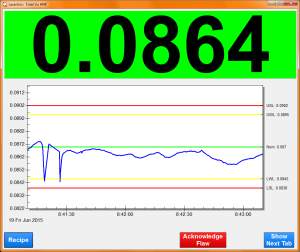Home > Products > Product and Process Monitoring > Total Vu™ HMI > Total Vu™ HMI Standard Features
Total Vu™ HMI - Highlights of Standard Features
Total Vu™ Capabilities
Reports using Excel ® templates
Max/Min for irregular and non-round profile measurement
Open Productivity and Connectivity (OPC®) software
Fast Fourier Transforms (FFT) and Structural Return Loss (SRL)
Off-the-shelf, Total Vu software accomplishes many important goals:
- Process scanning laser micrometer and UltraGauge+™ signals in real-time so you can instantaneously assess product quality and process trends
- View large readouts of product measurements and process variables with color-coded tolerance status and trend charts
- Use standard displays or adapt them, including buttons, to fit your exact needs
- Quick changeovers with unlimited recipe storage
- Summarize product quality and process capability with statistics display and reporting
- Detect and report any dimensional flaws using unique, built-in filtering so defects may be eliminated before reaching your customer or downstream processes
- Capture measurement data to disk or network storage devices for post-processing or record keeping
- Independent and simultaneous processing of measurements for SPC, flaw detection, measurement, and trending so each function works optimally for your operation
Support
In addition to traditional support methods–phone and email, one of the best standard features is interactive support via the Internet using the Quick Support application. Through Quick Support, LaserLinc support staff can see what you see on the screens and thus diagnose and solve problems quickly as well as provide training.
Hardware Options
The Total Vu HMI is Windows®-compatible software so you can choose the computing platform, whether industrial or desktop, laptop, mini-PC, or an all-in-one product. For turnkey systems, the μLinc™ processor with integrated TLAser400™ card and other I/O delivers the ultimate in ease of installation.
The hardware interface between the host Total Vu PC and the laser micrometers can be Ethernet (see NetLinc™) or LaserLinc’s plug-in data acquisition card. The UltraGauge+ Digital Signal Processor (DSP) connects via Ethernet.
Minimum PC Requirements
- Windows 7® (32- or 64-bit) or Windows 10, 2 GHz dual core processor, 4 GB RAM, 10 GB available hard disk space
- One monitor with a minimum of 900 pixels vertical resolution
For some systems, the monitor must be HD (1920x1080) resolution - Touch-screen (or similar) monitor, or keyboard and mouse
- If the system includes an UltraGauge+ DSP, a NetLinc micrometer or NetLinc interface, or a NetIO device:
One dedicated 100 Mb Ethernet port - If the system includes more than one of any combination of the UltraGauge+ DSP, a NetLinc micrometer, or NetIO device, an external network hub or switch with an appropriate number of connections is required
- If the system includes a laser micrometer without a NetLinc interface then a TLAser400 card is required.
One PCI or PCIe slot is required per TLAser400 card (slot type must match the card); slots must be directly on the motherboard (no T-slot) and they must accommodate full-height, half-length cards
Microsoft, Excel, and Windows are either registered trademarks or trademarks
of Microsoft Corporation in the United States and/or other countries.
OPC is a registered trademark of the OPC Foundation



